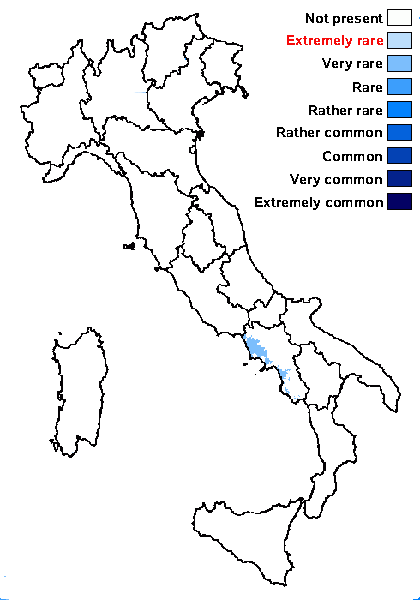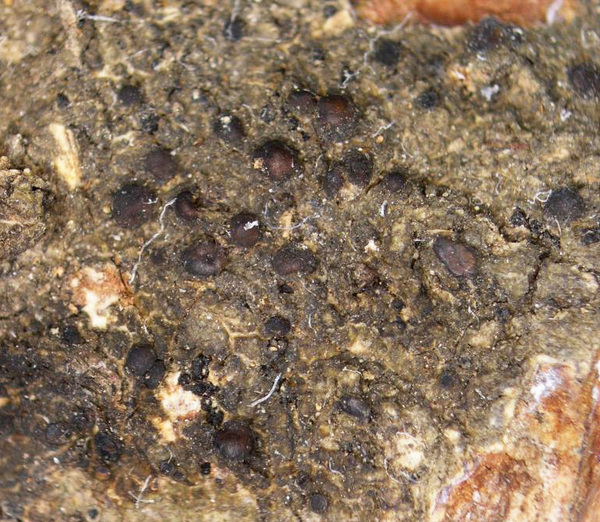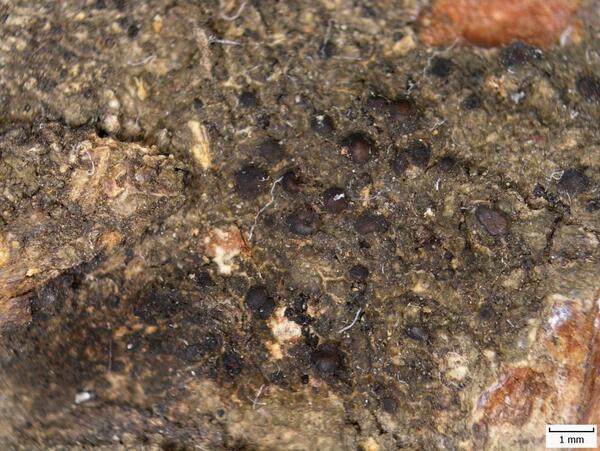Parvoplaca servitiana (Szatala) Arup, Søchting & Frödén
Nord. J. Bot., 31: 49, 2013. Basionym: Caloplaca servitiana Szatala in Rechinger - Denkschr. Kaiserl. Akad. Wiss. Wien, math. naturw. Kl, 105: 51, 1943.
Synonyms:
Distribution: S - Camp (Ravera & Brunialti 2013b, Ravera & al. 2015c).
Description: Thallus crustose, thinly episubstratic, dark grey, continuous to cracked. Apothecia zeorine/biatorine, brown-black, up to 1 mm across, with a flat to convex disc and a usually darker, finally sometimes excluded margin turning grey when wet. Thalline exciple 80-100 μm wide, usually hidden on lower side of the apothecial margin; proper exciple well-developed, 60-100 μm wide, dark grey and corticate in outer part, colourless within, the pigmented parts K+ and N+ violet; epithecium grey, K+ and N+ violet; hymenium colourless, c. 80 μm high; paraphyses sparingly branched, with swollen apical cells; hypothecium colourless. Asci 8-spored, clavate, functionally unitunicate, apically thickened with a broad internal beak, the inner part of apex and external cap I+ blue, Teloschistes-type. Ascospores 2-celled, polarilocular, hyaline, ellipsoid 14-15.5 x 5.5-7.3 μm, the equatorial thickening (“septum”) 5.5-8 μm (up to c. 1/2 of spore length). Photobiont chlorococcoid. Spot tests: thallus K-, C-, KC-, P-. Epithecium and outer part of exciple K+ and N+ violet. Chemistry: thallus without lichen substances; apothecia with the Sedifolia-grey pigment (without anthraquinones). Note: a black fruited epiphytic species described from Greece, included in the Italian red list of epiphytic lichens as “Critically Endangered” (Nascimbene & al. 2013c).
Growth form: Crustose
Substrata: bark
Photobiont: green algae other than Trentepohlia
Reproductive strategy: mainly sexual
Commonnes-rarity: (info)
Alpine belt: absent
Subalpine belt: absent
Oromediterranean belt: absent
Montane belt: absent
Submediterranean belt: absent
Padanian area: absent
Humid submediterranean belt: absent
Humid mediterranean belt: very rare
Dry mediterranean belt: absent

Predictive model
Growth form: Crustose
Substrata: bark
Photobiont: green algae other than Trentepohlia
Reproductive strategy: mainly sexual
Commonnes-rarity: (info)
Alpine belt: absent
Subalpine belt: absent
Oromediterranean belt: absent
Montane belt: absent
Submediterranean belt: absent
Padanian area: absent
Humid submediterranean belt: absent
Humid mediterranean belt: very rare
Dry mediterranean belt: absent

Predictive model
 INDEX FUNGORUM
INDEX FUNGORUM
 GBIF
GBIF



